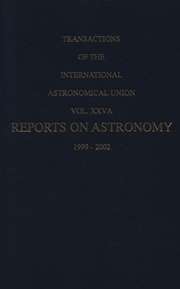No CrossRef data available.
Article contents
12 Solar radiation & structure
Published online by Cambridge University Press: 25 April 2016
Extract
Spatial structures in the solar photosphere are likely to be seen down to scales of the order of the photon mean free path, which is about 70 km in the lower photosphere. This scale corresponds to an angle of O.”1 at disk center. Structures associated with magnetic fields may be expected on even smaller scales. Existing solar telescopes typically have diameters of slightly less than one meter. Hence, even in the visible part of the spectrum, the scales of solar structures extend out to the diffraction limit of current solar telescopes. Therefore, the achievable spatial resolution is limited by turbulence in the Earth’s atmosphere (seeing). This has led to the development of various techniques to overcome this resolution limit and achieve diffraction-limited resolution. This report covers selected highlights and recent work done in the context of high-resolution techniques published in the period from July 1, 1993 to June 30, 1996. Due to the lack of space the report remains necessarily incomplete, and I apologize to all the authors of important contributions that are not cited here. This review does not cover space and balloon-borne instruments that try to achieve high spatial resolution by observing from above the Earth’s atmosphere. Recent work on ground-based high-resolution techniques has been collected in the proceedings of the 13th Sacramento Peak Summer Workshop on Real Time and Post Facto Solar Image Correction (Radick 1993).
- Type
- Division II - Sun & Heliosphere
- Information
- Copyright
- Copyright © Kluwer 1997


